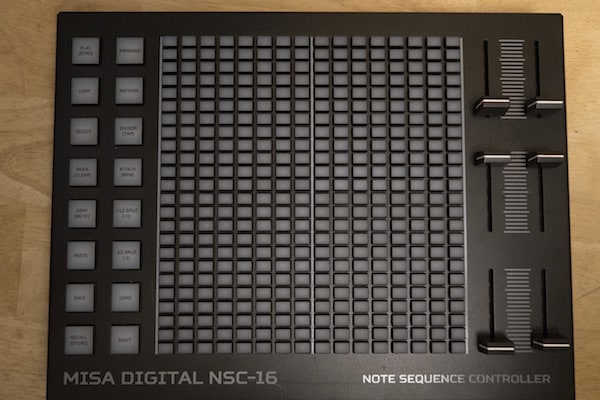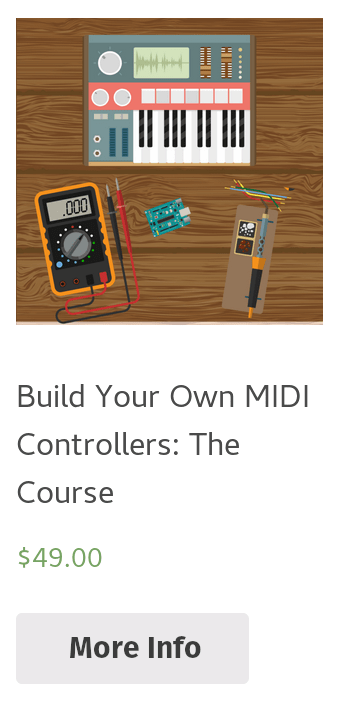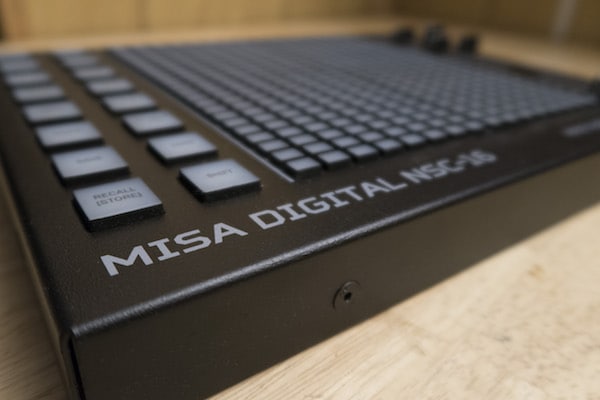MISA Digital NSC-16 Review: An Incredible MIDI Sequencer
Recently I got the extraordinary privilege to try out MISA Digital’s NSC-16 MIDI sequencer.
Now, I’ve seen a few videos about it in the past and was very impressed.
It comes in at around $680 and surprisingly ships anywhere in the world for free.
Video above: The NSC-32 functions exactly the same as the NSC-16, but has a 32×16 grid of buttons instead.
Setting up the MISA Digital NSC-16
The online instruction manual can be found here.
To be honest, it took me longer than expected to get set up on my Macbook Pro Mid-2015.
At first, I tried out the standard USB port on the MISA. The MISA only outputs serial data from their USB port so you’ll need a software such as the Hairless MIDI-serial bridge.
The directions to set up your MISA are:
WINDOWS
- Connect the NSC USB cable to the computer.
- Install loopMIDI for Windows. Under “Setup”, press the “+” button to add two ports named “loopMIDI_in” and “loopMIDI_out”. This only has to be done once on your system. LoopMIDI: http://www.tobias-erichsen.de/software/loopmidi.html
- Install Hairless MIDI-Serial bridge, and set the MIDI out port to be “loopMIDI_out” and the MIDI in port to be “loopMIDI_in”. Set the Serial port to point to the NSC COM port. Download: http://projectgus.github.io/hairless-midiserial/#downloads
- Set your DAW (eg. Ableton) MIDI configuration to use loopMIDI_out and loopMIDI_in ports.
MAC OS X
- Connect the NSC USB cable to the computer.
- Install the USB driver for your version of the OS-X. Then reboot. Download: http://www.ftdichip.com/Drivers/VCP.htm
- Install Hairless MIDI-Serial bridge, and set the MIDI out port to be your DAW MIDI output, and the MIDI in port to be your DAW MIDI input. Set the Serial port to point to the NSC /dev/cu.usbserial-xxxxxxxx or /dev/tty.usbserial-xxxxxxxx Download: http://projectgus.github.io/hairless-midiserial/#downloads
- Set your DAW (eg. Ableton) MIDI configuration to use loopMIDI_out and loopMIDI_in ports.
An easier way:
I wasn’t really a fan of the MIDI-serial bridge. Not to fret, there’s a better solution if you want to connect your MISA via USB.
The solution: Purchase one of these MIDI-USB cables.
Now all you have to do is connect the adapter cable to the MISA’s MIDI ports. Then, you can freely plug in the USB side to your computer.
Doing this eliminates the need for you to have to download any silly drivers or have to use any MIDI-serial software.

Making some beats! My first impressions:
After watching some of MISA’s getting started videos I found the musical workflow very intuitive. It’s one thing to learn the basics of inputting your notes, but once you take advantage of the 16 control buttons (the 2 columns of square buttons on the left of the sequencer) your mind will be BLOWN.
Here’s how I feel about the NSC-16 so far:
If you put the NSC-16 in the hands of talented musician this sequencer can become a very dangerous weapon! Whether you’re dealing with composition in the studio or playing your music live in a nightlub, the NSC-16 provides very easy-to-access controls that allow you to do insane things with your loops.
Practicality in a live setup
I see a lot of epic experimental MIDI controllers but not all of them are practical.
However, I believe the MISA Digital NSC-16 and also the NSC-32 are very practical.
Down below in the advantages section of this article, you’ll learn many of the reasons why this sequencer is highly recommended.
The advantages of the MISA NSC-16/32
- The multi-color LEDs are nice and bright if you’re in a dark environment
- The buttons are a good size, even if you have large fingers
- The build quality is very strong (it’s made out of a tough metal after all!)
- MISA Digital has great support that has helped me out big time over email.
- Buttons are made out of a high-quality rubber material.
- After playing around for a few hours, you’ll find the controls of the NSC very intuitive
- Fairly detailed documentation
The disadvantages of the MISA NSC-16/32
It was difficult to find downfalls of this product. Here are my only gripes:
- The USB output doesn’t output straight up MIDI. (I’ve gone over this earlier and provided a solution)
- I got stuck a few times setting up the NSC with my Mac. I eventually resolved all the issues with some tweaking thankfully!
Final Notes
The MISA Digital NSC-16 is both a fantastic studio and performance tool.
If you’re interested in getting your hands on a powerful sequencer while at the same time supporting an innotivate Australian startup, I highly recommend this controller!
Feel free to drop any questions in the comment section below!
Happy sequencing. :)



Leave a Comment